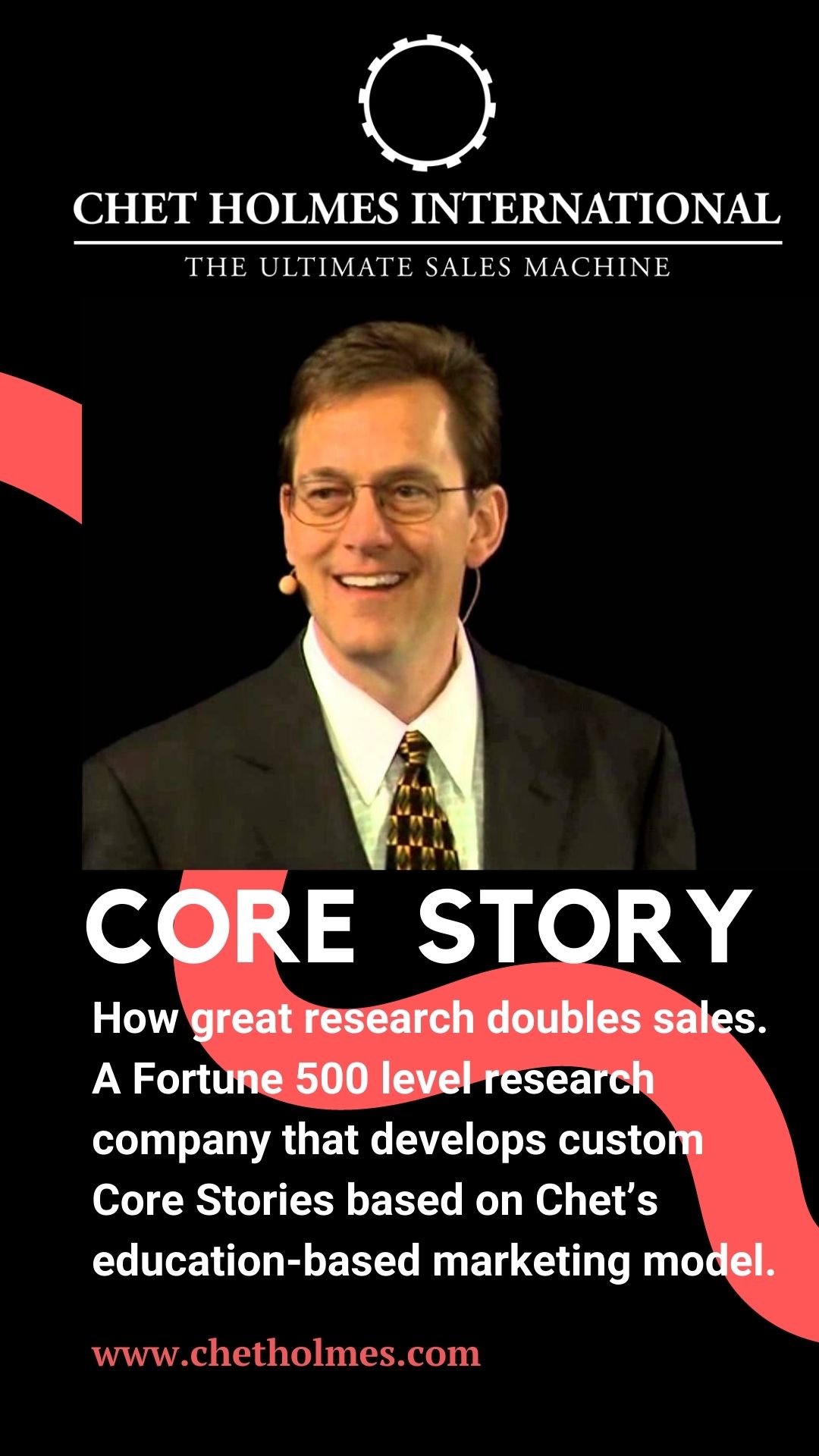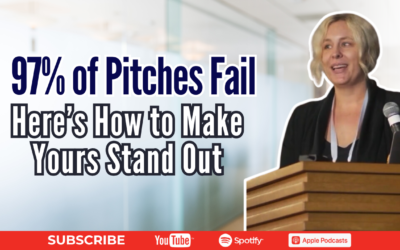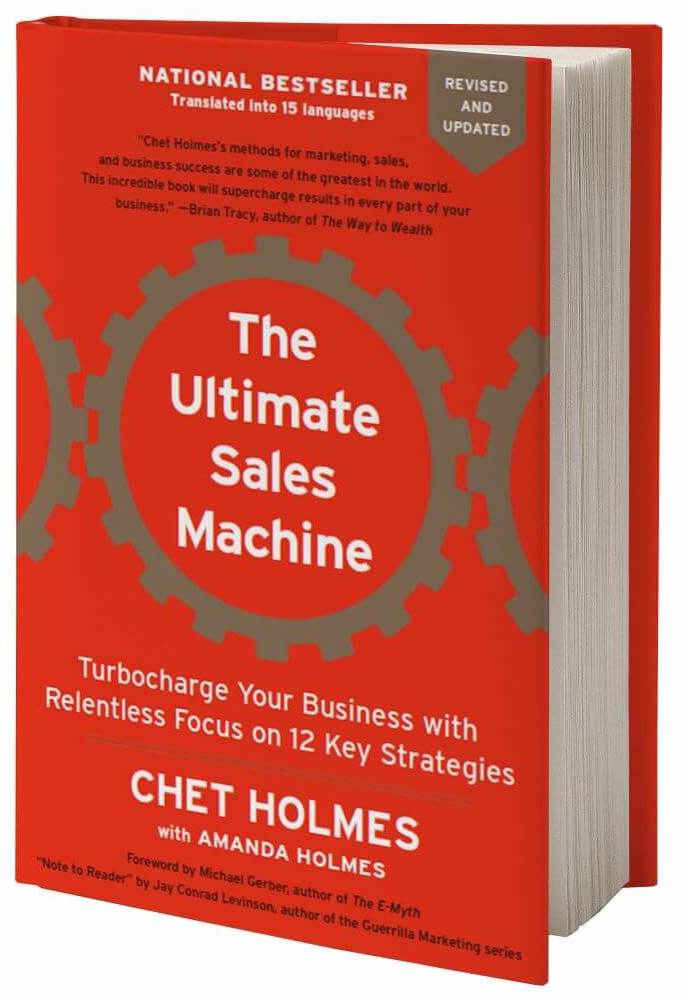We pulled this episode from the archives. You’ll enjoy this clip of our founder, Chet Holmes, training live on what the most successful companies do differently.
An article by the Harvard Business Review points out that only 10 percent of the population has what’s called a “learning mindset.”
That means that after basic education in school, 90% of the population wouldn’t choose to improve their skills. (Unless it’s part of their job requirement).
A brilliant way to gain a competitive edge in your marketplace is to do what the 90% overlook.
As Chet always said, “You don’t have to be a big company to act like a big company.”
In this week’s episode, you’ll discover:
-The best way to manage ANY company to success
-The skills it takes to scale your company from zero to $100 million and beyond
-How constant attention to this one thing can produce highly effective meetings dedicated to improve every aspect of your business
-Case study: how a business owner proactively worked on his business for only 13 hours a week from reactively working 70 hours a week, and what happened
Enjoy!
- Want to know what’s keeping you from doubling your sales in the next 12 months? Take our quick QUIZ to get answers: Howtodoublesales.com
- If you’d like to have a profound breakthrough in your business, schedule your breakthrough call with a LIVE expert here: Chetholmes.com/Breakthrough
- Claim your FREE chapter 4 from the top 10 most recommended marketing and sales books of all time! Visit: Ultimatesalesmachine.com to find out how you Create 9X More Impact from every move you’re already making to win clients!
TRANSCRIPT:
*this transcript was mostly generated by AI, please excuse any mistakes 
Okay, so self-study one-on-one, training and team training. So this will cover methods for each one of those self-studies for the one person armies. And then everything we teach can be done one-on-one or even by yourself. Everything can be done by yourself. So I just wanna make sure that we take care of you one person.
However, the more the better the impact, by the way, that’s why it’s great to have a coach if you’re one person, army, to have a coach who you work with, because they say when two mines come together, they form a third mine. That didn’t exist without the other two. Right? And I see this all the time in my own business with the key executives.
Last, yesterday in the hall, I came at one idea with, uh, came at an idea [00:01:00] with one perspective and the president of my companies came at it with a different perspective. Between the two of us, we created a third perspective. Neither one of us would’ve ever figured out. We both went, damn, that’s a good idea.
And it formed from the two mines coming together to create a third mine. So that’s what I want you guys to try and have those masterminds. If you’re that one person, army boy, it’s nice to have another person that you can have some kind of interaction with. And for those of you who have big. You know, I’m gonna show you how to maximize those resources like never before.
Okay?
So most companies have what we call the tribal method of training information passed from man to man by word of mouth. , take club, kill food. That’s the tribal method of training. That’s what most of you have. Yeah. Here, sit with Betty and learn what Betty does, and do what Betty. Yes. Okay. Well that’s not a great method of training.
The better your training, the better your everything. So it saves time. When offered the choice between the trial and error method of training and the training and trial method, employees and [00:02:00] bosses unanimously will take the training and trial method. Does that make sense? Okay. So obviously you’re gonna get more results if you have training and trial training and trial.
Deliberate and constant training radically improves employee’s understanding of company objectives. That’s another major benefit of training. And then training helps set standards for performance. So we have minimum acceptable standards for performance for every single area or function in every part of every piece of our business.
Minimum acceptable requirements for every person. Do you have that in your company?
Raise your hand. One of you, three of you. Okay. Take this test and see if you’re serious about your companies. This is true or false, and I want you to answer out loud with some energy please. Can I get some energy? Yes. Yes.
That was better. Okay.
True or false? All employees perform each aspect of their job with a high degree of excellence and consistency, and your company [00:03:00] company’s at true or false? False. Okay. Results are somewhat predictable because training and skills are consistent. False. Doesn’t feel good does it? Each supervisor would give a similar answer for each question or problem.
True or false? False. Each employee would give a similar answer for each question or problem. True or false? True. False. Okay. Client treatment is similar. No matter who the client deals with, true or false? Uh, all staff members know what is considered good. Performance or attitude. True or false? Okay. I got a couple.
So if you want the finest company or department possible, you must have consistent training. All these things are set with training. Have you set standards with training? Are all call-ins or walk-ins handled with great care and in a consistent manner? I had, uh, my cell phone started sending me messages.
This is a different cell phone now. Not the one I have now, but it started sending me messages, horoscope, the weather. I mean, I couldn’t believe it’s like every second seven messages were coming in over my cell phone, so obviously something went wrong. [00:04:00] So I call the six one one for my cell phone and I get on the phone and I don’t have a lot of time to deal with this.
And I’m driving along and my wife is listening. She’s next to me in the car. And um, I’m going, I’m telling this person, look, you gotta get this shut off. I can’t have this on my phone. And this, and. Well, sir, um, I don’t know what you’re saying. It must have been on there all along. Well, I’ve had the phone for four years and it hasn’t been on here all along, so it must be a new thing that, you know, you guys did in some way because it wasn’t here five days ago or five minutes ago.
And all of a sudden I’m getting five messages a second. Well, I don’t know. And so I’ve just got more and more annoyed and more and more annoyed and more and more obnoxious, and this person just got stupider and stupider , and I know, I know. That she was doing it to annoy me, , you know what I’m saying? You get that.
Well, I don’t know sir. And she just probably like, you know, covering her mouth and snickering at me and ended up hanging up on me. Okay. And that made me furious. And now I call in, I want a supervisor, I don’t wanna talk to a normal [00:05:00] person.
And, um, it’s just, so
have you done that with your staff? Have you talked about what do you get when, what do you do when you get that IRA customer calling in?
Who’s literally obn. Because I was annoyed, had no time to deal with this, getting five messages per second on my, on my cell phone. So you can even have fun with that. That could be fun, right? You take two of your customer service people and you start having a role play that with one guy’s acting really obnoxious you.
You probably have the entire staff laughing, but then you would learn how to handle that in a way that would be proactive, in a way that would make that customer feel like they were cared for it instead of pissing them off to where now I have a different cell phone. You heard me say that. Different cell phone company is employee activity, intermittent, moody, or maybe even indifferent or rude because you haven’t set standards through training.
You know what makes me crazy when I walk into any business and see the front desk person reading a book? Can you not find something for this person to do? You can’t tell me in any company that you have [00:06:00] enough resources and you have not enough to go on that you can have any person in any job sitting there reading a book.
This just makes me crazy. What’s the ideal procedure for initial contact with a client? Have you laid that out ideal? Like let’s set the standard. Here’s the minimum acceptable standard of what we’re gonna have. What are the six questions you will ask every client? What are the 10 follow-up procedures you will absolutely insist upon?
And again, we’re gonna work through all those. I’m gonna set those up for you if you don’t have them, so we will set them up for you. The more proactive training, the better the everything. So how fast can you grow at present? In my companies, we hire between 18 to 50 people a week. That is how fast we’re growing in the audience.
There are folks who hire 500 people a week. Who here has their company set up so well that you can hire 50 people this week and turn around and hire 50 more next week and not skip a beat? [00:07:00] Anybody have their company set up that way? The one guy and I helped, but you were good before I came along. Okay.
The first of the critical skills to which any serious business owner must be devoted must have this skill. This is a skill set you must have, and it’s called the three Ps. Studies show the most successful businesses are constantly focusing on these three Ps, and they are planning procedures and policies.
most important skill you can have unless you want a job and not a business, unless you want to have to work constantly for that business. The more you utilize the three P’s, the better the business runs without you. Does that make sense? Yes. Okay. This skill will overlay all the other competencies covered in every session here today, yesterday, every session you’re gonna.
For everything you learned, you want to constantly install these three P’s, so I’m gonna show you how to do it and it’s a terrific skill and it will [00:08:00] change your life if you have what kind of discipline. Okay, very good. In the industrial paint example, the plan was to use the core story sales model. So the first thing we did is we tested that with one of their current clients and then we tested it with another new client that we got in to see, and we tested it with their best.
And then once it worked, then we started putting in the procedures. We tested the procedures, and then we put in the policies by which the company was gonna set standards. And I can tell you one of the biggest mistakes that people make is they’ll get all this information from an event like this and you’ll turn around and you’ll go back and you have 10 sales people and you go, we’re gonna do this core story sales model now.
And, um, here’s some ideas on it, and go check it out and go increase sales. And you have 10 people now selling all differently than they’ve ever sold before. And do you think your sales are gonna go down or they’re gonna go up? They go down. And I have experienced [00:09:00] this personally where I’ve given a client all these ideas and they go back and say, all your ideas didn’t work.
And I go, well, well, what happened? Well, how’d you do it? Well, well, I explained it to all my sales people. Okay, so these are really important and they need to be. and they need to be worked on. And when you’re trying to institute something new in your company, do you want to use your best people or your worst people?
Okay, this is the first group that ever got that right. Let me say it in a way that you can’t get it wrong. When you want to do something in your company that you absolutely wanna make sure works, do you want to use your best people best? Or do you wanna use your worst people? Some people still getting that one wrong.
It’s your best people. If you want it to work, use your best. So everything I’ve ever done with any group, I want to use their top producer. I wanna use the best person to make the idea work. Okay? And then it says every McDonald’s runs with the same quality control. So you can go into McDonald’s [00:10:00] in Harlem and get the same exact Big Mac as you can get in Hollywood or Beverly Hills.
Same exact thing. So that’s the way you need to be. You need to be that procedure. The best way to manage any company, large company model. You break the company down into manageable pieces, what we call impact areas. You work on improving each of these each week, which I’m gonna go deeper on one person Army, it’s the same thing, but instead of guiding the staff to improve these areas, which we’ll cover, you have to work on them yourself.
Okay? So a larger company model. I had a client and he is about a $50 million company. And he was outta control, just outta control, trying to keep up with the business. He was working 70 hours a week and so I took his company and I knew it pretty well. Cause we perform an audit on it. When we first work with a company, we, or interview up to 20 people in the organization and by the time we’re done, we’ll know the company better than the.[00:11:00]
And you’re thinking, no, there’s no way, but we have a method. We do this, we’re really good at it, and we’ll come back with things the owner didn’t even know. It’s amazing. I’m talking about larger companies, obviously. So I had this client and I said, all right, we need to break your company down into impact areas.
And then what I’m gonna want you to do is I’m gonna want you to focus on those impact areas once a week. So here are his impact areas, and you don’t have to write these down cuz they’re in your book. So I have this 50 million company and I have. I personally broke this down for him. He didn’t have to break it down, but here were his impact areas.
Okay. It’s 50 million company outside sales. In his case, he has an outside sales force that goes out and makes outbound calls and then he is got inside telemarketing a different group. Totally different skillset, right? So I don’t want to have those people have the same meeting where they do a totally different job, but they’re both, I.
Impact areas following me so far. Okay, and you can write these down [00:12:00] as we go. Then he has marketing. That’s an important impact area in any company, isn’t it? Okay. Then he has customer service, in his case of 50 million company, so he is got whatever it is, 20 customer service people then, and that’s an important area, isn’t it?
Okay. Then he has crm, which is his whole customer relationship management process, which includes both marketing and sales, and is tied to te. Then he has purchasing and supplies. In his case, he’s a distributor. Very important area of the company, right? How they buy stuff, how they get their supplies, what supplies they’re gonna carry, what they think is going to sell.
Then he has shipping and receiving. Again, they’re a distributor. They get in huge quantities of stuff, and they ship it out. He hadn’t looked at chipping and receiving in 10 years. Had no idea what was going on in that part of the company. Then he had inventory control. This is a 50 million company sitting on 2 million of inventory that’s over a year old, not [00:13:00] on top of it, not looking at it, totally reacting to the business.
This guy got there with pure blood, sweat, and tears, and he needed what to go to the next. New skills. New skills. That’s what he needed. Then accounts receivable, again, a huge area for him. He had to make sure that he was on top of his collection. I mean, when I got there, like all this stuff was messed up.
Uh, hr, he had no involvement at all with HR hiring standards, not involved and yet reacting. You would think the guy was like doing a great job by how much work he was. Technology, obviously important for any company. And I love Evan Pagan’s stuff last night about how this one now and this one here, these three here and this are all now tied together.
Technology and marketing and customer relationship, that’s all becoming the same thing now. Okay, partner, uh, relations and vendors. Important thing. Cause this guy’s a distributor, so they have to constantly get new vendors, um, partner relationships with affiliates. So this is something he didn’t even [00:14:00] have.
But you, larger companies, you should have an affiliate director person in your company who is designed to go out and look for those affiliates. Other people that can have products or services that you can sell, even if you don’t stock store or ship them, or people who can market your stuff to their databases.
Uh, and then exporting. He had an export division and then California Initiative, he had an initiative to attack a new market. So what new things do you have that you want to get? . done And at first it seemed crazy. He says, you want me to have 15 meetings a week? Are you crazy? I’m not gonna get anything done.
And I almost said to him, you’re getting very little done now,
, so it’s gotta be an improvement. Uh, he said, that’s gonna kill my time. There’s no way I’m gonna be effective at that. So first question is he first problem was that he didn’t know how to run a meeting. And as I said, when we started, where do you learn?
You know, do you, thank you, . But seriously, I [00:15:00] mean, where do you learn to hold a killer meeting? I mean, and I’ve had this in really big companies where they just don’t know how to hold a really highly pro productive meeting. So they don’t wanna hold any meetings because they’re had the largest calendar company in the world as a client.
And the guy’s like, ah, I stopped having meetings cause he turned into bitch sessions. That’s poor leadership. That’s a guy who doesn’t know how to hold a good. So he is not holding a good meeting. He ended up getting more done proactively managing his business in just 13 hours per week. Why? Because he didn’t have 15 hours of meetings.
Some of the meetings were half an hour, some were 15 minutes, but none, none are more than an hour. An hour. I’m gonna teach you all the rules for these meetings. Then he did RO working 70 hours a week, reacting to the business and his staff. . loved it There were people in all those divisions I just showed you who were, weren’t getting answers and things were waiting three months, five months.
Now they’re getting fixed in three days, three weeks, because every week he is forced to see you in that meeting and deal with your problems where he wasn’t dealing with them and they just all [00:16:00] waited. So proactively managing the company in 15 hours a week, this guy got more done than he did in 70 hours week and it took a tremendous amount of what kind of discipline to get this working. And then after a while it was just amazing because he got everything done in Monday, Tuesday, Wednesday, in the summertime. He has a boat. He loves the boating thing, like me, in the summertime, he only works three day, three days a week.
That’s it. Takes 40 a week, weekend every single week because he doesn’t have to work in the business anymore. He’s worked on it and he’s perfected it and polish. . So in the example I just gave, I can’t, he can’t think of a better way to spend his time Now. He spends 13 hours per week working on the business, improving some aspect of it, and the rest, if any, working in it.
So this is how businesses get stuck. They stop working on the business. Some of these areas get 15 minutes, some will get an hour, but your objective is to take each and move it forward each week.
So what are your impact area? So we gave you the [00:17:00] examples and since you don’t have them, I apologize, but yours are gonna be different anyway.
In fact, I’ll page back and put them up on the screen. How’s that? Okay, so do a little workshop right now. Write down your impact areas and for most of you, by the way, shouldn’t be 15, even really big companies should be more like six. This guy just had a mess. Everything was broken. For most of you, it’s gonna be six.
Seven.





 Get your pre-sale copy of the new edition of The Ultimate Sales Machine! (With special limited time bonuses)
Get your pre-sale copy of the new edition of The Ultimate Sales Machine! (With special limited time bonuses)
0 Comments